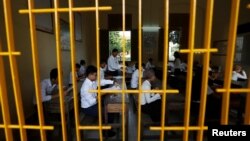Cambodian children's rights continue to be infringed on despite improvements in recent years, new reports and experts say ahead of Children's Day in Cambodia on Saturday.
The KidsRights Index, published in May, ranks Cambodia 128 out of 181 countries on children's rights. The report, which looks at indicators that include health, education and children's protection, finds that economic growth does not lead to better implementation of children's rights.
The kingdom scored worse than neighboring Thailand, (ranked 14), Vietnam (ranked 57), and Laos (ranked 112), and scored only slightly better than Myanmar (ranked 133).
Huy Khy, Save the Children's senior policy advocacy adviser, said although significant progress had been made in the legal framework for the protection of children's rights, implementation remained fragile.
"Despite this remarkable progress, children in Cambodia are still experiencing a number of challenges and needs related to learning, protection, health, and participation," he said in an email to VOA.
For example, children with disabilities lacked opportunities and were twice as likely to be out of school compared to children without disabilities.
"Only 4% of adolescents with disabilities have completed a lower secondary education, compared to 41% of their peers without disabilities," Khy said.
Citing a 2014 UNICEF statistic, Khy said that more than 50 percent of children experienced physical violence, 25 percent of children were emotionally abused, and about 5 percent experienced sexual abuse.
And while the enrollment rate had improved over the years, Khy said that only a much smaller proportion of pupils received a secondary education.
"Often, parents and children choose work over education for children," he said.
Financial commitment
The low ranking in the KidsRights Index, which also took into account the efforts of countries and their available resources, was closely intertwined with the budget allocated for the protection of children, the advocate said.
"Cambodia, however, has not yet allocated sufficient budget to ensure the full realization of children's rights," Khy said. "For example, in 2019, the education budget is only 13.7% of the total national budget, which is still lower than the global benchmark of 20% of the total national budget."
This is also reflected in a new Save the Children document, titled "Childhood Report: Changing Lives in our Lifetime," which was released Tuesday. The report ranks Cambodia 120 out of 176 countries, and raises concerns over the 22.5% of children of elementary and secondary school age who don't attend school.
Overall, only 2 to 4 percent of the local budget was allocated for social services, Khy said.
Ministry of Social Affairs spokesman Yeap Malina was unavailable for comment. A Social Affairs official directed questions to the ministry's spokesman before hanging up on a reporter.
Lingering gaps
UNICEF Cambodia's communications specialist, Bunly Meas, highlighted "important steps" that the Cambodian government had taken to improve children's rights over the past 10 years, such as passing multiple laws and action plans designed to protect children, reducing of the poverty rate, and improving education. Yet, Bunly said, gaps remain.
"While the gains made in relation to child rights in Cambodia have been significant, there remain challenges in closing gaps in some areas," he said.
By way of example, he cited statistics showing that 32 percent of children in Cambodia were stunted, and that the mortality rate for children under 5 was 31 per 1,000 live births, despite having fallen.
"All issues are interrelated and we need to address them at the same time," Bunly said.








